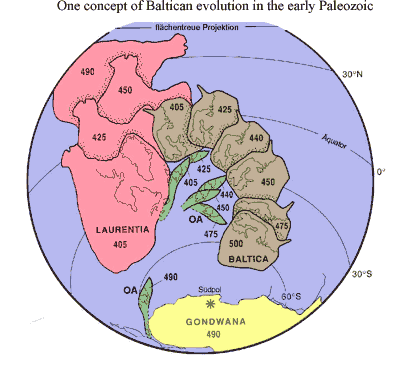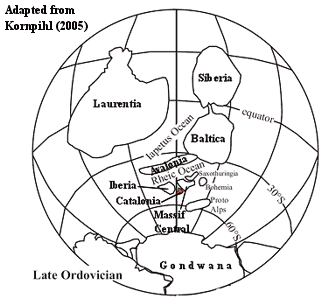|
|
Geography |
| EARTH |
Baltica-
Catalonia |
Baltica to Carpathians
Baltica
 (a) Paleoproterozoic to Late Ordovician Continent Baltica formed in the Paleoproterozoic from the fusion of three cratons: Fennoscandia (Scandinavia, the Baltics, Belarus, Eastern Poland, part of Scotland, and northern European Russia), Volgo-Uralia (the Volga Basin of Russia), and Sarmatia (the Trans-Caucasus region, the Ukraine, Moldavia and part of Romania). Gee & Stephenson (2006). At some early point, Baltica also picked up additional real estate in the regions of Novaya Zemlya and Svalbard. Baltica merged with the supercontinent Rodinia in the Neoproterozoic. However, it refused to get involved in the south polar Rodinian reunion which became Gondwana the others non-conformists being Laurentia, Siberia, and Kazakh). Each of these continental blocks carried with it a broad and shallow coastal shelf where Cambrian marine life flourished, with a unique and indigenous fauna developing around each continent.
(a) Paleoproterozoic to Late Ordovician Continent Baltica formed in the Paleoproterozoic from the fusion of three cratons: Fennoscandia (Scandinavia, the Baltics, Belarus, Eastern Poland, part of Scotland, and northern European Russia), Volgo-Uralia (the Volga Basin of Russia), and Sarmatia (the Trans-Caucasus region, the Ukraine, Moldavia and part of Romania). Gee & Stephenson (2006). At some early point, Baltica also picked up additional real estate in the regions of Novaya Zemlya and Svalbard. Baltica merged with the supercontinent Rodinia in the Neoproterozoic. However, it refused to get involved in the south polar Rodinian reunion which became Gondwana the others non-conformists being Laurentia, Siberia, and Kazakh). Each of these continental blocks carried with it a broad and shallow coastal shelf where Cambrian marine life flourished, with a unique and indigenous fauna developing around each continent.
During the Ordovician, Baltica and Siberia drifted toward Laurentia (Baltica drifting mostly west), creating a loose collection of large land masses separated by shallow coastal seas. The Silurian meeting of the continents Laurentia and Baltica to form Euramerica (or Laurussia) caused the Acadian /
Caledonides Orogeny (mountain building period), with all the usual belching of volcanoes, messy climate changes, etc. that generally accompany this sort of thing. Fortunately, by this time, Baltica was in the process of consolidating eastern Avalonia, Armorica, and other bits and pieces. It had thus became Europe, and consequently blamed the whole thing on North America.
Baltica is one of the older cratons, probably built on basement rock dating back to Late Archean or Paleoproterozoic times. Hacker et al. 2003). MAK. Revised ATW090207.
See Perunica.
Late Ordovician to Devonian Terrane Assemblage. The term Cadomia or Cadomian is used in several senses, and it is not always clear what is meant by the term. Cocks & Torsvik (2006). Operationally, it seems to refer to Paleoproterozoic basement rock with a particular geochemical signature. Rock with this signature is a strong indicator that the terrane in which it is found was originally part of Gondwana. Thus the phrase "Cadomian basement" means "probably from Gondwana." It is used to describe terranes from Florida to the Red Sea which rifted from Gondwana, including lands associated with both Avalonia and (especially) Armorica.
On the other hand, it can also refer to a particular portion of East Avalonia which became part of Spain. See, e.g., Veevers (2005). Stampfli et al. (2002), refer to the Cadomian block in Spain as "Cadomia sensu stricto."
Another use of the term is almost coextensive with Armorica only, on the theory that Armorica, as originally named, referred to a plate; whereas the various "Armorican" terranes are not actually a coherent tectonic entity. Zulauf et al. 2004). In this sense, it is identical with the "Armorican Terrane Assemblage." Stampfli et al. (2002), refer to this Cadomia as "Cadomia sensu lato." These authors believe that Cadomia (s.l.) rifted off Gondwana in the Early Ordovician, but re-accreted to the coast of Gondwana. Later a much larger mass, the Hun Superterrane, detached from Gondwana and subsequently moved north to merge with Baltica. ATW080318.
Caledonian (or Caledonide) Orogeny
Late Ordovician to Early Devonian Mountain-building episode in Baltica and Laurentia. The Caledonian Orogeny was a prolonged mountain-building episode caused by the collision of at least two island arcs (Avalonia and Armorica) with Laurentia and Baltica, beginning in the Middle or Late Ordovician, and the subsequent merger of Baltica and Laurentia to form Laurussia during the Silurian. These collisions closed the Tornquist and Iapetus Oceans. In Baltica, the effects of Caledonian mountain-building were felt as far east as Poland. Two major mountain ranges were raised in Baltica, the British/Irish Caledonides (related to the arrival of Avalonia) and the Scandian Caledonides (related to the formation of Laurussia. The sediment weathering from these Caledonide ranges was the source of the "Old Red" sandstone deposited in Silurian and Devonian times. Cocks & Torsvik (2005); Cocks & Torsvik (2006); Nawrocki & Poprawa (2006). ATW080320.
 Cretaceous to Present Mountains of Eastern Europe. The Carpathians are a chain of mountains located in Eastern Europe, primarily in Slovakia and Romania. Their basement rock is of Gondwanan, and probably "Armorican", origin.
Cretaceous to Present Mountains of Eastern Europe. The Carpathians are a chain of mountains located in Eastern Europe, primarily in Slovakia and Romania. Their basement rock is of Gondwanan, and probably "Armorican", origin.
The geological history of the Balkans tends to be at least as complex as their political history, and the Carpathians are no exception ... The Pannonian Basin is sometimes referred to as the Carpathian Basin. Prior to the Cretaceous a pre-Carpathian range extended NW to SE along the margin of the Eurasian craton, and the Pannonian Basin was a foredeep southwest of this range. More mountains were raised, beginning in the Albian, with the reshuffling of small crustal fragments, and the range was deformed into its present shape by the force of small plates (notably Apulia and Moesia) being forced against Eurasia by the approach of Africa, particularly in the Paleogene, and ending in the earlier Miocene. One might speculate that the Pannonian Basin was squeezed into the old rift between Fennoscandia and Sarmatia, the northwest and southeastern halves of the original Baltica craton.
We do not yet attempt to describe the earlier history of this region. For recent reviews, see Iancu et al. (2005) and Csontos & Vöntös 2004). ATW080326.
 Catalonia, or the Catalan Terrane, is of Gondwanan (Middle Ordovician) and "Armorican" origin, part of Western Europe since the Middle Devonian (or possibly as late as the Mississippian). The Catalonian Terrane is more or less coextensive with Catalonia, the far northwestern corner of Spain in the area of Barcelona.
Catalonia, or the Catalan Terrane, is of Gondwanan (Middle Ordovician) and "Armorican" origin, part of Western Europe since the Middle Devonian (or possibly as late as the Mississippian). The Catalonian Terrane is more or less coextensive with Catalonia, the far northwestern corner of Spain in the area of Barcelona.
The Catalan terrane rests on basement rock of Cambrian age. It is often portrayed as migrating from the Gondwanan (African) coast somewhat behind (i.e. south of) and between the Iberian Massif and the Massif Central or Montagne Noir terranes of Spain and France, respectively. Perhaps as a result, it was even slower to reach Laurussia than most Armorican terranes. Paleomagnetic data suggest a latitude of 30° S. as late as the Pridoli. The Iberian Massif, Saxothuringia and the Catalan Terrane all share faunal elements with Perunica Bohemia), but it has been difficult to judge whether these were actually in contact, or simply inherited a common fauna from Africa. Nysaether et al. (2002). On the other hand, the faunal similarity between Catalan and the Spanish and French massifs is too close to allow much separation between them at any time.
The Catalan terrane may have been composed of up to three separate units, which now form the Eastern Pyrenees Mountains, the Catalonian Coastal range, and perhaps the Balearic Isles. ATW080330.
page uploaded 5 April 2002
revised ATW080330, edited RFVS111106
checked ATW030914
 (a) Paleoproterozoic to Late Ordovician Continent Baltica formed in the Paleoproterozoic from the fusion of three cratons: Fennoscandia (Scandinavia, the Baltics, Belarus, Eastern Poland, part of Scotland, and northern European Russia), Volgo-Uralia (the Volga Basin of Russia), and Sarmatia (the Trans-Caucasus region, the Ukraine, Moldavia and part of Romania). Gee & Stephenson (2006). At some early point, Baltica also picked up additional real estate in the regions of Novaya Zemlya and Svalbard. Baltica merged with the supercontinent Rodinia in the Neoproterozoic. However, it refused to get involved in the south polar Rodinian reunion which became Gondwana the others non-conformists being Laurentia, Siberia, and Kazakh). Each of these continental blocks carried with it a broad and shallow coastal shelf where Cambrian marine life flourished, with a unique and indigenous fauna developing around each continent.
(a) Paleoproterozoic to Late Ordovician Continent Baltica formed in the Paleoproterozoic from the fusion of three cratons: Fennoscandia (Scandinavia, the Baltics, Belarus, Eastern Poland, part of Scotland, and northern European Russia), Volgo-Uralia (the Volga Basin of Russia), and Sarmatia (the Trans-Caucasus region, the Ukraine, Moldavia and part of Romania). Gee & Stephenson (2006). At some early point, Baltica also picked up additional real estate in the regions of Novaya Zemlya and Svalbard. Baltica merged with the supercontinent Rodinia in the Neoproterozoic. However, it refused to get involved in the south polar Rodinian reunion which became Gondwana the others non-conformists being Laurentia, Siberia, and Kazakh). Each of these continental blocks carried with it a broad and shallow coastal shelf where Cambrian marine life flourished, with a unique and indigenous fauna developing around each continent. Cadomia
Cadomia Cretaceous to Present Mountains of Eastern Europe. The Carpathians are a chain of mountains located in Eastern Europe, primarily in Slovakia and Romania. Their basement rock is of
Cretaceous to Present Mountains of Eastern Europe. The Carpathians are a chain of mountains located in Eastern Europe, primarily in Slovakia and Romania. Their basement rock is of 